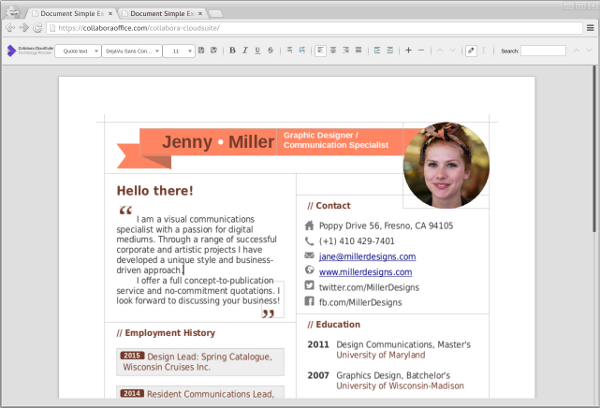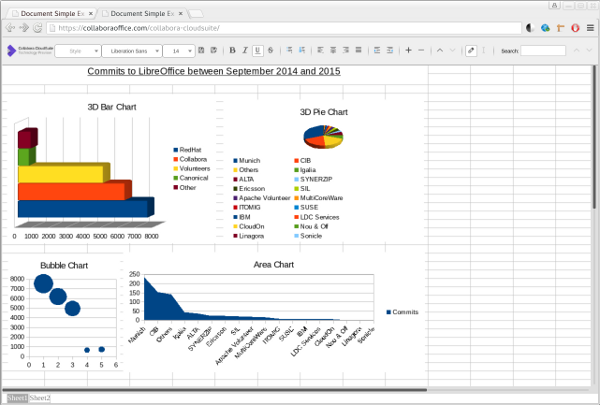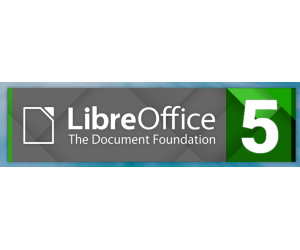Introducing CloudSuite – taking LibreOffice to the cloud.
by Sam Tuke and Niall McCarthy
Before the end of 2015, Collabora (www.collaboraoffice.com), the driving force behind putting LibreOffice in the Cloud, will release its much anticipated Collabora CloudSuite. This version of the best known open source office suite comprises desktop, mobile and web components, but much attention is anticipated for the web client for cloud.
 The initial release of the web client will concentrate on rendering documents with some light editing capabilities. The subsequent release within six months will deliver collaborative editing functionality and within the year a whole gamut of rich editing tools will be included to ensure an unparalleled user experience.
The initial release of the web client will concentrate on rendering documents with some light editing capabilities. The subsequent release within six months will deliver collaborative editing functionality and within the year a whole gamut of rich editing tools will be included to ensure an unparalleled user experience.
CloudSuite will be a high value enabler in any corporate technology strategy, while bringing significant cost savings over traditional solutions. Collabora’s Open First approach is dedicated to ensuring customers can make the most of their applications and build long-term infrastructures around them without the ground always moving under their feet. Open Standards-oriented design backed up by long-term support come with CloudSuite by default.
Every business values its information, and it is in this context that Collabora CloudSuite shines. When you pass your information to the Cloud, you want to know it’s still yours. CloudSuite allows you to protect this while simultaneously delivering the functionality of a modern document suite.
Upon release, Collabora CloudSuite will be available as Linux packages for easy installation. Web client and web server can be deployed separately. Multiple protocols for remotely accessing files will be supported, including WebDAV. Current performance targets indicate 1,000 concurrent users on a 64-Core server.
Listening to Users
The user experience is central to Collabora’s efforts. While giant cloud marketing may try to get us caught up in a rush to the cloud, the reality is that the user experience is a hybrid of several form factors: cloud, mobile and the often forgotten (by marketing chiefs at least) desktop which still dominates corporate and government landscapes everywhere, and will do so for a long time to come.
Secondly, the offline experience remains key. Documents-on-the-Go or Documents Anywhere are great facilities, but local continuous access and control are more highly valued features. For all the usefulness of the web and cloud, they’re still subject to interruption, slow downs and iffy data management.
A strong document suite doesn’t exist in a vacuum. Users understand this and therefore understand that service provider choice can be critical. So too can choice of the architecture in which your document suite is deployed.

Collabora CloudSuite strikes the delicate balance of empowering the user while enabling the business to take confident steps towards the cloud. The desktop client feature set is more powerful than ever, while the web client concentrates on world-class document rendering (over one hundred document formats supported), fidelity (e.g. between Microsoft Office formats), and performance.
Sync and Share
Building a document cloud should add value to your business and that value should not come at the expense of confidentiality, integrity or accessibility to data. The value-add in most cases is that information is easier to access and easier to share. The downside (at least to date) has been that information is often housed either far away, in a markedly different legal jurisdiction, or simply by businesses who seek to mine information for their own ends.
Collabora CloudSuite has been designed to accommodate as many file syncing and sharing technologies as possible. This means that not just documents and how they are shared remain in the customer’s control, but also the entire identity management and storage integration if so desired.
Such capacity to define and facilitate the customer experience highlights CloudSuite’s adaptability, and Collabora’s recognition that both choice and convenience drive buying decisions. Added value should never come with a hidden cost.
Groupware
A key component in the CloudSuite strategy has been to integrate with Groupware. The giant clouds have already proven this model, albeit with some obvious drawbacks.
With this in mind, we’re working with world class software partners to drive a unified office experience. Your Calendars, Contacts, Tasks, Instant Messaging, Telephony, Email and Documents, all in one place of your choosing.
Groupware is central to all business’s productivity stack. Along with the document suite, email tends to be where most unstructured data lives. Close integration is often essential for reasons of security, storage, and practicality.
More Power to the User
Built on the principle of being better than Google and more flexible than Microsoft, Collabora CloudSuite will enable businesses everywhere to set up their own document clouds on their own terms.
- Who can access my data?
- Where would I like it stored?
- How would I like it backed up?
- What applications would I like to analyse my data?
All controlled at the behest of the customer.
Truly customer centric document clouds have been largely ignored by the giant clouds of the world because it doesn’t suit their business models which depend on capturing all customer data in one place.

The power of Collabora CloudSuite, an open source software suite, lies in rebalancing the market in favour of smaller local clouds rather than giant clouds and, of course, in the creation of private or hybrid clouds should the user so wish.
While only a handful of credible public document clouds currently exist, Collabora is on a mission is to enable thousands, and millions more that are private or hybrid thereafter.
Keeping what you value closer to home
What happens to their data is important to every user, whether they realise it our not. Much of any business’s intellectual property resides in documents and many prefer to keep as close an eye as possible on their prized assets. Building security and compliance policies is not a “one size fits all” exercise, as some would like to convince us.
For the compliance-conscious businesses of today, the Open Source model holds many advantages. The underlying code can be inspected, the software can be installed locally, and the terms and conditions of hosting can be negotiated in line with corporate policy.
World Class Interoperability
It’s not just about physical and logical control over your data, it’s also about knowing that your data will remain useful over time. In a world where we accumulate ever increasing quantities of information, conflicting data formats are frustrating.
Collabora CloudSuite has industry leading document interoperability at its heart, supporting the rendering of over a hundred different document formats. This includes unparalleled interoperability with present and back-dated versions of Microsoft Office formats, open document formats and many others.

Such innate openness drives business continuity, reduces long-term costs and provides a valuable platform for increased productivity – not just for today, but for the information lifecycle as a whole.
Driving Standards
While interoperability is a priority for every business, it’s also important to build according to standards. Being flexible is one thing, but interoperability needs to be anchored to a point of reference, something that’s accountable to us over the short, medium and long-term.
Collabora is one of the biggest contributors to the Open Document Standards (ODF) and the CloudSuite product reflects this in its architecture.
In fact, ODF is our default file format and the many thousands of clouds we build will all be underpinned by the ODF standard.
Such a constant foundation increases market choice and reduces vendor or service provider lock-in to near zero or zero. Putting your document data in a cloud is a big step. Collabora ensures that it’s a sure step and that changing direction will always remain an option.
Different Shaped Clouds
Every business is unique. As a vendor with a strong service history, Collabora understands this better than most. In the decade since it was founded it has delivered market defining integrations to a wide spectrum of industries.
Collabora CloudSuite can be tailored to your requirements. Some infrastructures have unique architectures. Some are bound by tight compliance regulation while others have specific use cases.
Furthermore, some product service offerings can benefit from the addition of CloudSuite, but need to ensure the customer experience and its accompanying branding are consistent with what they have been accustomed to.
The document suite is key to business productivity. Collabora believes that such essential technology should work for the customer. Mandatory accommodation of vendor expectations should be a thing of the past. Your transition to the cloud should accommodate your technology strategy, not determine it.
This has just been a brief introduction to how LibreOffice is being taken forward to provide a cloud based solution. Stay tuned for further announcements and look forward to the release of CloudSuite.
This article was first published in OH Magazine Issue 31, 4/2015, p19-21. Please SUBSCRIBE if you wish to see the full article.

